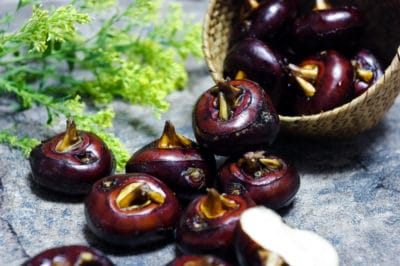Water Chestnuts in the Wild
The Chinese water chestnut (Eleocharis dulcis) — a staple of Oriental cuisine — grows wild in Asia, Australia, Polynesia, India and New Guinea.
Its primary natural habitats include:
- Wetland margins
- Freshwater, brackish or salty swamps
- Rice paddies, especially low-lying ones
European Water Chestnut
Don’t confuse Chinese water chestnuts with the European water chestnut (Trapa natans). Native to Eastern Europe, Africa, Asia, China and Malaysia, it’s cultivated for its edible nuts.
Since being imported to the United States in 1874, the European water chestnut has spread enough to be listed as invasive in:
- Vermont
- New Hampshire
- Massachusetts
- Connecticut
- Rhode Island
- New York
- Pennsylvania
- Delaware
- New Jersey
- District of Columbia
- Virginia
It’s also made the noxious weed lists of North Carolina, Florida and Washington State.
Water Chestnuts Under Commercial Cultivation
Only Chinese water chestnuts are cultivated commercially, most of them from mainland China, Hong Kong and Taiwan. They’re rated suitable for USDA plant hardiness zones 8 and higher, and a few cultivation attempts have occurred in California, Hawaii, Florida and Georgia. The labor costs, however, made those ventures unsustainable.
Growing Conditions
As aquatic plants, Chinese water chestnuts grow in soil saturated with water. They do best in fertile clay and sandy loams or humus-rich muck soil from drained swampland. It should be from 2 to 8 inches deep and free of rocks or debris. Fertilizing the soil with organic chicken manure one or two months before planting increases the harvest.
Expert gardener’s tip: Although Chinese growers prefer clay loam or muck soil for their water chestnuts, both tend to harden into chunks that need to be broken apart at harvest time. Some U.S. growers found working with sandy loam much easier.
Home-Grown Water Chestnuts?
If you’re considering growing water chestnuts, be aware that after planting, the corms need seven months of frost-free weather to reach maturity. Harvest usually occurs in late fall, one month after the fields are drained and when the plants’ vegetative growth has died back.
